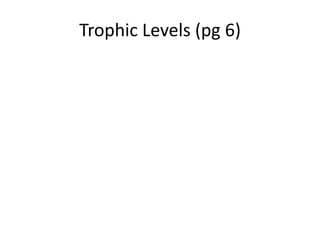Primary producers use energy from the sun or chemicals to produce organic molecules. Consumers rely on other organisms for energy and nutrients. There are different types of consumers including herbivores, carnivores, omnivores, scavengers, decomposers, and detritivores. Food chains show the transfer of energy between organisms through eating, while food webs show complex feeding relationships in an ecosystem. Trophic levels refer to the steps in a food chain, with primary producers at the base and increasing consumer levels above. Only about 10% of available energy is transferred between trophic levels.













